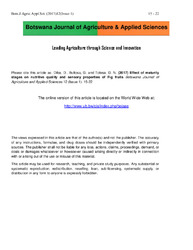Effect of maturity stages on nutritive quality and sensory properties of Fig fruits
Abstract
This study was conducted in a completely randomized design to evaluate the physical character, proximate composition, minerals (Fe, Zn, Ca and P) and sensory properties of early, mid and late maturity stages of Ficus sur fruits (FSF) collected from five trees. The physical parameters were determined at the sample collection site. Fresh fruit samples collected were used for sensory evaluation. The other sub-sample was dried at 65°C for 48 h to constant weight and stored in a sealed plastic bag at refrigeration temperature (5°C) for nutrient content analysis. The early maturity stages of FSF was most preferred except for its taste in which the late maturity stage was the best accepted fruits. The early maturity stage attained the highest fruits size, crude fat, crude protein and aril weight. The late maturity stage attained the highest dry matter, crude fiber and total carbohydrate. Iron and zinc contents were high for late maturity stages while calcium and phosphorus contents were high at early stages. The condensed tannin contents were not significantly different among the three maturity stages. The study showed that harvesting FSF at early maturity stage would be best for most sensory preferences and physical characteristics while late maturity stage is better for most of the nutrient contents analyzed.

